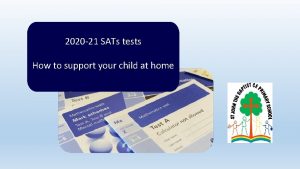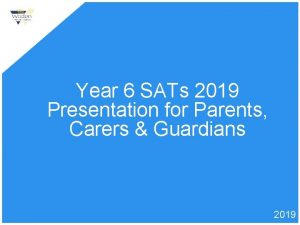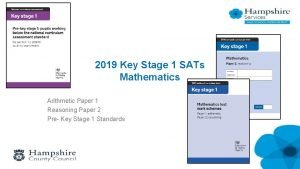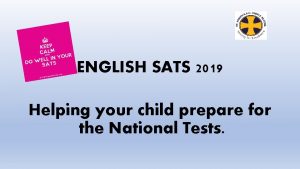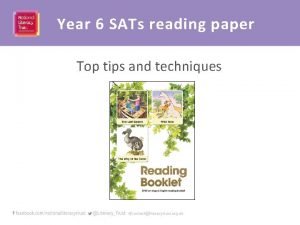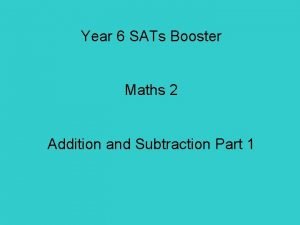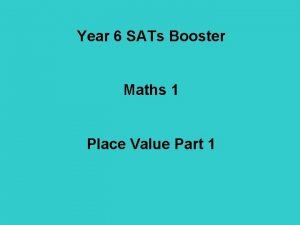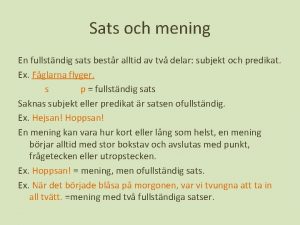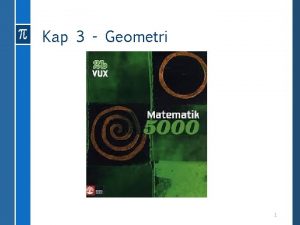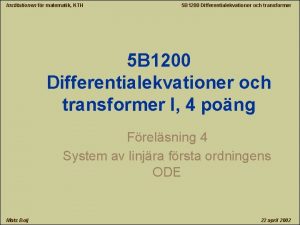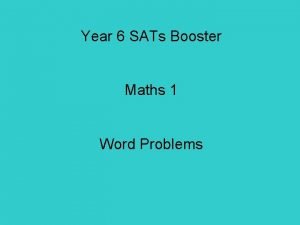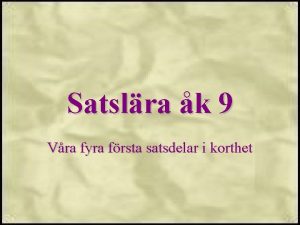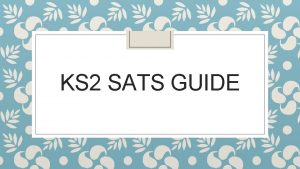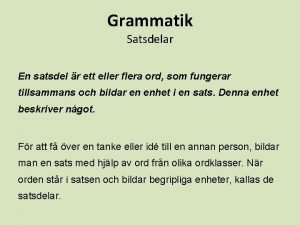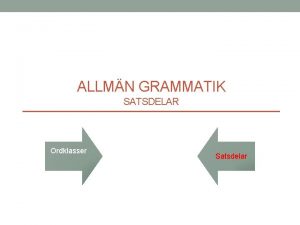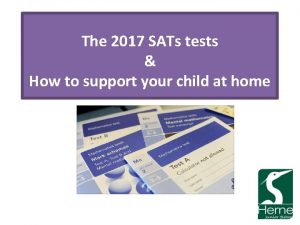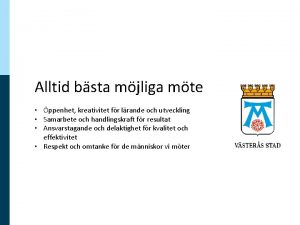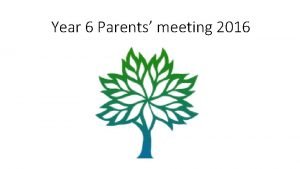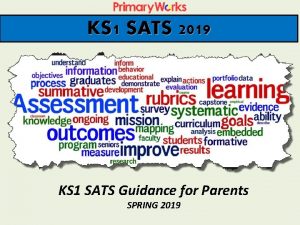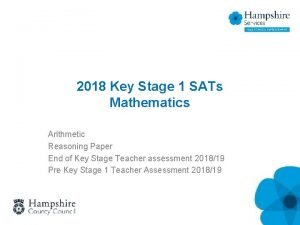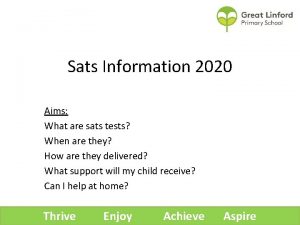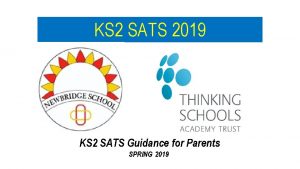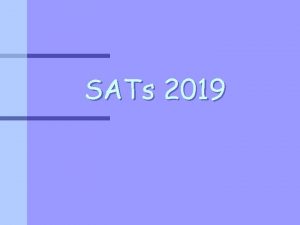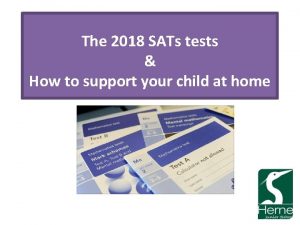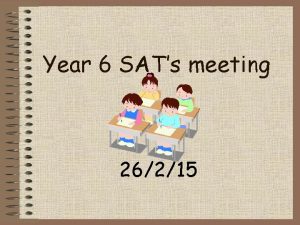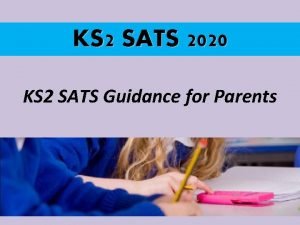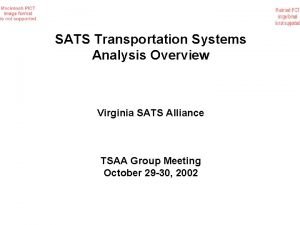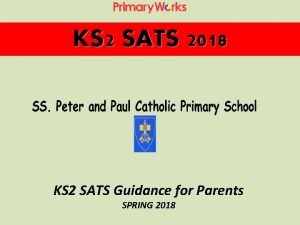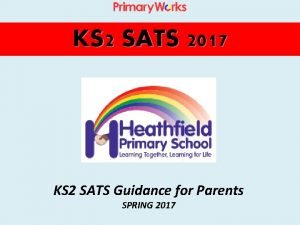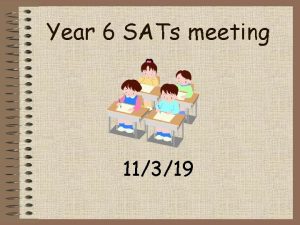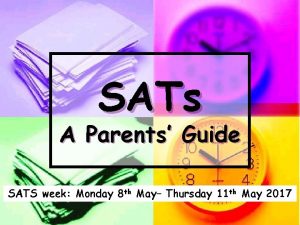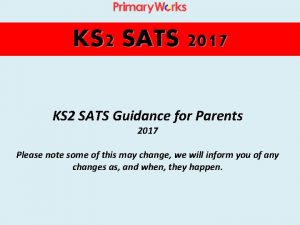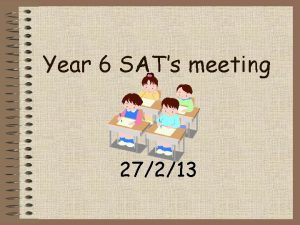The 2019 SATs tests How to support your






































- Slides: 38

The 2019 SATs tests & How to support your child at home

Our vision for the tests • Our priority is always the happiness of your children and we want them to think of the week as any other week. • We want the children to be as calm as possible which is why we practise the tests. • Regrettably, the tests are possibly more important than ever before. • The Government are putting more emphasis then ever on the tests both for the school and the children. • The children have also been working extremely hard and we want them to have a sense of pride when they receive their results.

The changes o In the summer term of 2016, children in Year 2 and Year 6 took the first new SATs papers. These tests in English and Maths reflected the new national curriculum, and were intended to be more rigorous. There was also a completely new marking scheme to replace the existing national curriculum levels. o These tests are set and marked externally, and the results will be used to measure the school’s performance (for example, through reporting to Ofsted and published league tables). Your child’s marks will be used in conjunction with teacher assessment to give a broader picture of their attainment. o The children are expected to reach the expected standard – ‘secondary ready’.

The changes

The changes • The children will sit tests in Reading, Maths and Spelling, Punctuation and Grammar (SPAG). • The mental maths test has gone and has been replaced with an arithmetic paper. • They will now sit 2 maths reasoning papers which replace the old paper A and paper B. • Reading and SPAG remain the same. • Writing will continue to be teacher assessed. • For all the tests, the expected standard is significantly higher than previous years.

The timetable • All the tests will take place in the week commencing 13 th May. • Monday 13 th – SPAG: Punctuation & Grammar (45 mins) and Spelling (Approx. 20 mins) • Tuesday 14 th –Reading (1 hour) • Wednesday 15 th – Arithmetic (30 mins) and Reasoning 1 (40 mins) • Thursday 16 th – Reasoning 2 (40 mins)

The set-up • Most of the children will sit the test in their classroom. • Some will sit the test in the hall or in other rooms. • This will be based upon what is best for the individual child. • A small number of children will have a reader for the SPAG and Maths papers. • In order to have a reader, the child’s reading age has to be at least 2 years below their actual age. • All other children can have questions read to them but they must ask for the help (excluding Reading paper).

The reading test • The reading test will be a single paper with questions based on three passages of text. Your child will have one hour, including reading time, to complete the test. There will be a selection of question types, including: • Ranking/ordering, e. g. ‘Number the events below to show the order in which they happen in the story’ • Labelling, e. g. ‘Label the text to show the title of the story’ • Find and copy, e. g. ‘Find and copy one word that suggests what the weather is like in the story’ • Short constructed response, e. g. ‘What does the bear eat? ’ • Open-ended response, e. g. ‘Look at the sentence that begins Once upon a time. How does the writer increase the tension throughout this paragraph? Explain fully, referring to the text in your answer. ’

Sample reading paper

Sample reading paper

Sample reading paper

Sample reading paper

Sample reading paper

The grammar, punctuation and spelling tests (SPAG) • The grammar, punctuation and spelling test will consist of two parts: a grammar and punctuation paper requiring short answers, lasting 45 minutes, and an aural spelling test of 20 words, lasting around 20 minutes. • The grammar and punctuation test will include two sub -types of questions: • Selected response, e. g. ‘Identify the adjectives in the sentence below’ • Constructed response, e. g. ‘Correct/complete/rewrite the sentence below, ’ or, ‘The sentence below has an apostrophe missing. Explain why it needs an apostrophe. ’

Sample grammar paper

Sample grammar paper

Sample grammar paper

Sample grammar paper

Sample grammar paper

Sample grammar paper

Sample grammar paper

How to support your child with SPAG: Spelling, Punctuation And Grammar • Help your child learn the spellings that are sent home. • When reading to and/or with your child discuss the use of inverted commas to mark speech, the use of parenthesis (brackets) to additional information, the use of capital letters etc. • Revision books. Unfortunately, the grammar paper relies on a child knowing the terminology e. g. subordinate clause, main clause, adjective, article, passive, active – and many more. We use these in daily teaching practice however, for additional support at home, we are selling a revision book for a low price.

The maths papers • Paper 1 (Arithmetic) will consist of fixed response questions, where children have to give the correct answer to calculations, including long multiplication and division. Papers 2 and 3 (Reasoning) will involve a number of question types, including: • Multiple choice • True or false • Constrained questions, e. g. giving the answer to a calculation, drawing a shape or completing a table or chart • Less constrained questions, where children will have to explain their approach for solving a problem

Sample KS 2 maths arithmetic questions 3+7 4 8 17 × 1 1 2 95% of 240 234, 897 - 45, 996 1, 440 ÷ 12 20 − 4 × 2 = 15. 4 − 8. 88 42 1. 52 × 6 48 ÷ 6

Sample KS 2 maths arithmetic questions

Sample KS 2 maths reasoning questions

Sample KS 2 maths reasoning questions

Sample KS 2 maths reasoning questions

Sample KS 2 maths reasoning questions

Sample KS 2 maths reasoning questions

Sample KS 2 maths reasoning questions

Sample KS 2 maths reasoning questions

Sample KS 2 maths reasoning questions

How to support your child with maths • Help your child to learn and secure their times tables. We recommend the Dorling Kindersley 10 minutes a day app. • Practise the formal written methods. • Ask your child time questions such as what time was it ½ an hour ago?

General Top Tips • Top tip 1 – Keep supporting your children with their homework and daily reading. • Top tip 2 – Encourage your child to work at speed. Try timed recall of times table facts. Set 1 minute challenges – ‘You have 1 minute to find the word on the page that means dangerous. ’ ‘What is 10% of 150? You have 10 seconds. ’ • Top tip 3 – Make sure that your child realises that getting stuck is not a problem – encourage them to move on and then come back. • Top tip 4 - Encourage your child to believe in themselves.

The obvious stuff • • Make sure that your child gets plenty of sleep. Ensure that they have a good breakfast. Keep them relaxed in the evenings. They can bring in a lucky charm or mascot.

Revision SPAG Revision Guides Information as well as questions!

Questions
 Sats tests 2020
Sats tests 2020 Year 6 sats 2019
Year 6 sats 2019 Year 6 sats 2019
Year 6 sats 2019 2019 arithmetic paper
2019 arithmetic paper How to prepare your child for sats
How to prepare your child for sats Sats revision timetable
Sats revision timetable ıniqlo
ıniqlo Sats revision tips
Sats revision tips Sats booster maths
Sats booster maths Sats booster maths
Sats booster maths Sats week
Sats week Rumsadverbial exempel
Rumsadverbial exempel Steiner's theorem
Steiner's theorem Topptriangelsatsen
Topptriangelsatsen Fundamentalmatris
Fundamentalmatris Gurmit paid £21 for five presents
Gurmit paid £21 for five presents Ofullständig sats
Ofullständig sats What are sats
What are sats Sats grammatik
Sats grammatik Att-sats
Att-sats 2017 arithmetic paper mark scheme
2017 arithmetic paper mark scheme Sats 2017 reading paper
Sats 2017 reading paper Sats västerås
Sats västerås Pythagoras sats problemlösning
Pythagoras sats problemlösning Year 6 sats 2016
Year 6 sats 2016 1 ks sats
1 ks sats Arithmetic sats 2018
Arithmetic sats 2018 Example of major point
Example of major point Give us your hungry your tired your poor
Give us your hungry your tired your poor Hình ảnh bộ gõ cơ thể búng tay
Hình ảnh bộ gõ cơ thể búng tay Slidetodoc
Slidetodoc Bổ thể
Bổ thể Tỉ lệ cơ thể trẻ em
Tỉ lệ cơ thể trẻ em Voi kéo gỗ như thế nào
Voi kéo gỗ như thế nào Chụp phim tư thế worms-breton
Chụp phim tư thế worms-breton Hát lên người ơi
Hát lên người ơi Môn thể thao bắt đầu bằng từ đua
Môn thể thao bắt đầu bằng từ đua Thế nào là hệ số cao nhất
Thế nào là hệ số cao nhất Các châu lục và đại dương trên thế giới
Các châu lục và đại dương trên thế giới
